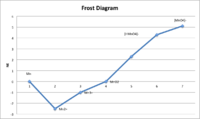Frost diagram

Okay, kiddo, have you ever seen ice form on the ground or on the window when it's really cold outside? Well, that's called frost! And a frost diagram is a special kind of diagram that scientists use to help them understand how substances can turn into frost.
First, we need to talk about something called oxidation. This happens when a substance reacts with oxygen in the air and it can cause some parts of the substance to lose electrons (which are tiny negatively charged particles). When lots of these reactions happen all at once, it can create a bunch of different substances all mixed together.
So when scientists make a frost diagram, they first start by choosing a substance they want to study. They put that substance in the middle of the diagram and draw a bunch of lines coming off of it. Each of these lines represents a different amount of electrons that could be lost during an oxidation reaction.
Then, they add some other elements to the diagram that might be around the substance, like oxygen or hydrogen. These also have lines coming off of them representing how much electrons they could lose.
Finally, they can use the lines to figure out which reactions might happen between the substance and the other elements. They can look at where the lines intersect and see if there's a chance that the substance could lose electrons and turn into another substance (maybe even frost!).
So, basically, a frost diagram is like a really cool map that helps scientists understand how substances can transform into different things when they're around other stuff like oxygen or hydrogen. And it's all because of something called oxidation!
First, we need to talk about something called oxidation. This happens when a substance reacts with oxygen in the air and it can cause some parts of the substance to lose electrons (which are tiny negatively charged particles). When lots of these reactions happen all at once, it can create a bunch of different substances all mixed together.
So when scientists make a frost diagram, they first start by choosing a substance they want to study. They put that substance in the middle of the diagram and draw a bunch of lines coming off of it. Each of these lines represents a different amount of electrons that could be lost during an oxidation reaction.
Then, they add some other elements to the diagram that might be around the substance, like oxygen or hydrogen. These also have lines coming off of them representing how much electrons they could lose.
Finally, they can use the lines to figure out which reactions might happen between the substance and the other elements. They can look at where the lines intersect and see if there's a chance that the substance could lose electrons and turn into another substance (maybe even frost!).
So, basically, a frost diagram is like a really cool map that helps scientists understand how substances can transform into different things when they're around other stuff like oxygen or hydrogen. And it's all because of something called oxidation!
Related topics others have asked about:
